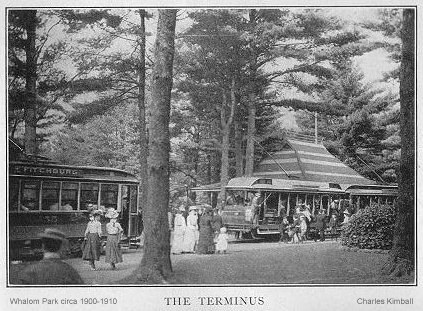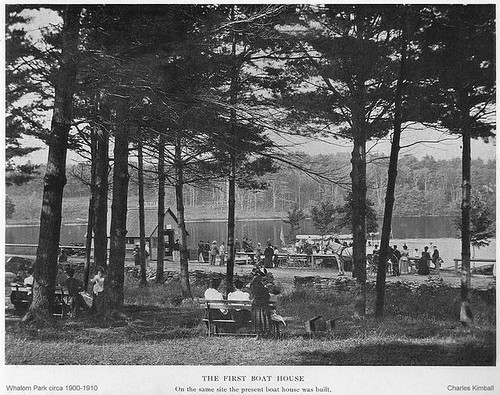If you know park history, you will realise that Lunenburg's WHALOM PARK is a 'classic amusement park' that followed the emerging trends in America from the very beginning; from the birth of picnic parks up through various additions and sophistications of the times and lasted right up through the Disney era, when all the rules suddenly changed. DAWN OF THE AMUSEMENT PARK (late 1800's) [1]
Following the American Civil War in the late 1800’s, increased urbanization
gave rise to electric traction (trolley) companies. In Whalom's case, it was the 'Fitchburg and Leominster Street Railway Company'. At that time, utility
companies charged the trolley companies a flat fee for the use of their
electricity. As a result, the transportation companies looked for a way to
stimulate weekend use, or weekend ridership.
This resulted in the amusement park. Typically built at the end of the trolley
line, amusement parks initially were simple operations consisting of picnic
facilities, dance halls, restaurants, games, and a few amusement rides often
located on the shores of a lake or river. These parks were immediately
successful and soon opened across America [2].
"THE FIRST BOAT HOUSE - On the same site the present boat house was built ". From a rare book by the Fitchburg & Leominster Street Railway Co. entitled "Whalom Lake and Park" circa 1910. Donated by Charles Kimball.THE MIDWAY AND CONEY ISLAND
The amusement park entered its golden era with the 1893 World's Colombian
Exposition in Chicago. This World's Fair introduced the Ferris Wheel and the
amusement midway to the world. The midway, with its wide array of rides and
concessions, was a huge success and dictated amusement park design for the
next sixty years. The following year, Capt. Paul Boynton borrowed the midway
concept and opened the world's first modern amusement park - Paul Boyton's
Water Chutes on Chicago's South side.
Unlike the primitive trolley parks, the Water Chutes was the first amusement
park to charge admission and use rides as its main draw rather than picnic
facilities or a lake. The success of his Chicago park inspired him to open a
similar facility at the fledgling Coney Island resort in New York in 1895 [2].GROWTH CYCLES
The amusement park industry grew tremendously over the next three decades. The
center of the industry was Coney Island in New York, which at its peak was
home to three of America's most elaborate amusement parks along with dozens of
smaller attractions.
Around the world, hundreds of new amusement parks opened, while many early
trolley parks expanded by adding new rides and attractions. New innovations
provided greater and more intense thrills to the growing crowds. By 1919, over
1,500 amusement parks were in operation in the United States.THE DEPRESSION / WORLD WAR II
Unfortunately, this development did not last for long [2]. In
1929, America entered the economic depression, and by 1935 only 400 amusement
parks remained; many struggling to survive. World War II further hurt the
industry, when many parks closed and others refrained from adding new
attractions due to rationing.
With the end of World War II, America and the amusement park industry enjoyed
post war prosperity. Attendance and revenues grew to new records as new parks
opened across America.BABY BOOMERS
A new concept, the Kiddieland, took advantage of the post-war baby boom,introducing a new generation to the joys of the amusement park in the rapidly
growing suburbs. Unfortunately, this resurgence was short lived [2].
As the 1950's dawned, television, urban decay, segregation, and suburban
growth beganto take a heavy toll on the aging urban amusement park. The
industry was again in distress as the public turned elsewhere for
entertainment. What was needed was a new concept and that new concept was
Disneyland.BEYOND DISNEY - Diversification [1]
The U.S. theme park industry is diversifying into new smaller-scale targeted
products for “niche” markets which may not be covered by the large-scale theme
parks.
Some feel that this trend is being driven by market opportunities like those
which drove expansion of the theme park industry several decades ago. The
theme park development boom in the 1970s represented a massive, heavily
capitalized response to the need to provide baby boomers with family
entertainment. Theme parks fit into the urban fabric of America by being
located next to large, built-in metropolitan markets, and on relatively
inexpensive land.1980’s
The 80s witnessed a narrowing of market and product focus with the smaller
investment waterparks. This was the first major diversification of the
industry. Waterparks appealed to a more narrow market, usually teens and young
families, and were suitable for smaller secondary markets. 1990’s
The new entertainment attractions of the 90s represent a furthering
diversification. These attractions narrow the niche appeal even more with
smaller capital investment and an appeal usually to very specific market
groups such as children, teens, young singles, etc. Many of these attractions
begin to tap the “baby boomlet”, and respond to the need to regenerate
under-performing suburban real estate properties by locating in shopping
centers.
Examples of the new entertainment attractions include the family entertainment
centers being developed in malls, the expansion of the outdoor family
recreation and mini-golf attractions, entertainment centers combined with
urban mixed use projects, sports bars, themed restaurants, children’s
attractions, mini-aquariums, and a host of others. THE FUTURE
Diversification should continue as entrepreneurs attempt to seek out untapped
entertainment markets.
This article is excerpted from
[1] http://www.hotel-online.com/Trends/ERA/ERARoleThemeParks.html
[2] Kyriazi, Gary. The Great American Amusement Parks. Secaucus, N.J.: Citadel Press. 1976. 256p.
Thursday, January 18, 2007
EVOLUTION OF AMUSEMENT PARKS IN AMERICA
Posted by Ted at 1/18/2007 04:00:00 am
Labels: History
Subscribe to:
Post Comments (Atom)
Whalom Park's Fan Box
Whalom Park on Facebook

0 comments:
Post a Comment